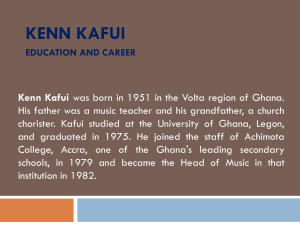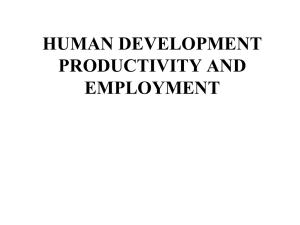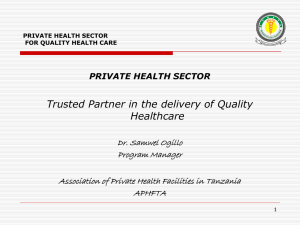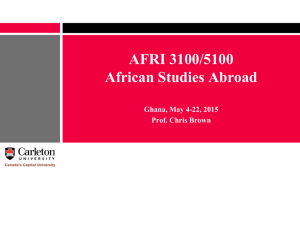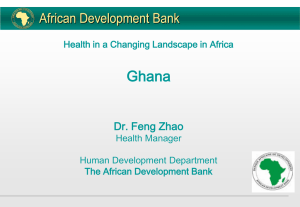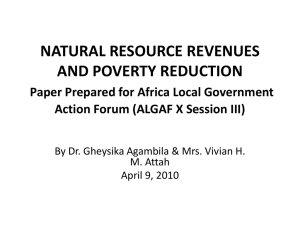Ensuring Equitable Development for Ghana
advertisement
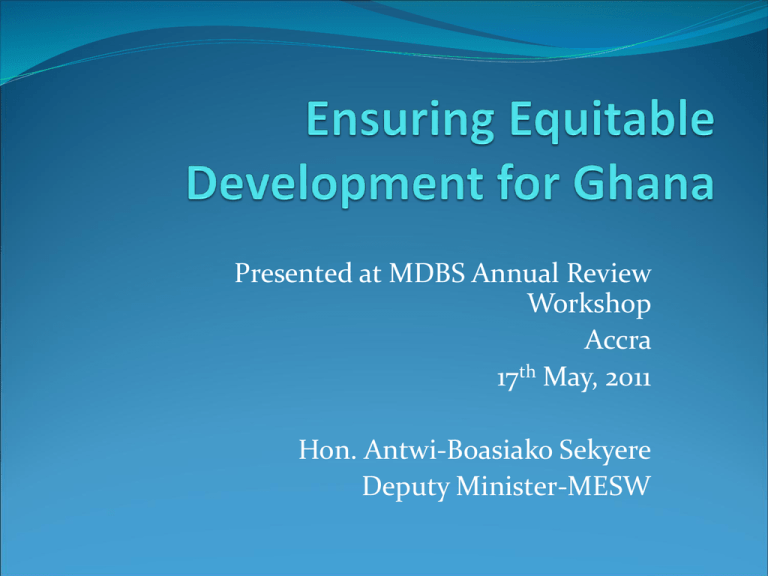
Presented at MDBS Annual Review Workshop Accra 17th May, 2011 Hon. Antwi-Boasiako Sekyere Deputy Minister-MESW Presentation outline 1. 2. 3. 4. 5. Defining equitable development Context - Achievements & Challenges Some Evidence and Issues Drivers of inequity, and Some possible Solutions. Defining equitable development • Equal access to economic and social opportunities for all Ghanaians irrespective of socio-economic, cultural and regional barriers. - i.e. giving all economic and social groups equal opportunities to strive and improve their living conditions. • Equal access to development opportunities irrespective of gender disparities. • There is (1) horizontal equity (across regions) and (2) vertical equity (across income/ wealth groups). . Defining equitable development Cont. Opportunity to contribute to development according to ability and sharing fairly in national gains. Why Equitable Development? The concept of equity in development is based upon the philosophy of “everybody matters” promotes social harmony and sense of belonging. prevents sectarian conflict. harnesses all the different talents for development. ensures inter-generational solidarity. (national) reduces regional disparities. Ghana is among the top ten performers in poverty reduction (Source: Ghana Poverty Assessment: Tackling Poverty in Northern Ghana, World Bank, Accra, 2011) Nigeria South Africa Mongolia Argentina Turkey Malaysia Russian Federation Pakistan Lithuania Egypt, Arab Rep. Burundi Guinea-Bissau Philippines Poverty Reduction (percentage points, annual change) Lesotho Poverty increase (percentage points, annual change) Moldova Cambodia Niger Azerbaijan Ghana Senegal Mali Vietnam -4 -3 -2 -1 0 1 2 3 4 Context -Some Achievements & Challenges Achievements • Poverty Reduction Head counts poverty has fallen from 52% in 1991 to 28% in 2006 (GLSS5). • Ghana is on track on many MDGs-malnutrition, primary school enrolment, and gender disparity. But • Health MDGs- Maternal Mortality, U5 mortality and sanitations are not on tareget. • Major Regional disparity in poverty and extreme poverty eg. Health and Education. Context -Some Achievements & Challenges Challenges • significant regional disparities in poverty between the northern Savanna regions (58%) and the rest of the country (19%) persist(the Savanna belt accounts for 51% of national poverty). • In health, 94% of births by women from the richest quintile are attended by skilled service providers whereas the figure drops to 24% for the poorest quintile. • In Education, a woman from the poorest quintile is likely to have less than one year of education whereas the woman from the highest quintile will have 9 years. Corresponding figures for males are 1.4 and 11 years respectively. • Ghana is unlikely to attain the under-5 mortality and sanitation MDG targets. Some Evidence and Issues poverty reduction has a regional bias with the Savanna region having the highest poverty and associated food insecurity and vulnerability. similar regional inequity in access to Basic Services and Human Development outcomes (Health and Education) The poor, irrespective of location, access fewer and lower quality service with respect to development outcomes. Some Evidence and Issues cont. on average, about 63% of students going to schools located in districts of the top quintile passed the BECE exams in 2008/09, whereas only 40 percent of students who resided in the districts of the poorest quintile passed. Eg. Similar inequity patterns are likely to be found in Agric extension, water supply, Health etc Students from the richest 20% represent two thirds of the students in highly subsidized public higher education and also the transition from secondary to higher education favors the richest Enrollment in Public Higher Education Institutions by Quintile(2005/06) 2nd quintile 8% Poorest quintile 2% Middle quintile 9% Enrollment in Secondary Public Schools by Quintile (2005/06) Richest quintile 24% Poorest quintile 12% 2nd quintile 17% 4th quintile 14% Richest quintile 67% 4th quintile 23% Middle quintile 24% Regional bias in Poverty Reduction in Ghana (Source: Ghana Poverty Assessment: Tackling Poverty in Northern Ghana, World Bank, Accra, 2011) Regional access to basic health services Regional Equity in access to Basic Health Services 70 66.3 60 Percentage 50 45.5 40 33.6 30 30.3 28.5 21.8 21.9 18.4 20 17.2 11.7 10 0 Sick women unable to access health facility due to distance Women delivered at home Children(1-2yrs) received all basic vaccination [1] Northern Regions[2] Children U5 underweight Children U5 with diarrhoea Other Regions[3] Notes: [1] BCG, measles, and three doses of DPT and polio vaccine (excluding polio vaccine given at birth). [2] Northern Regions comprises of Upper East, Upper West and Northern Region. [3] Other Regions comprise of Greater Accra, Western, Ashanti, Brong Ahafo, Eastern, Central and Volta Regions. Source: Ghana Demographic and Health Survey 2008. Regional and Income discrepancies observed in education access and outcomes Average Years of Schooling by Region, Wealth Quintile and Gender 12 10 Female Male 8 6 4 2 Age Residence Region Wealth Quintile To ta l Lo w Se est co M nd id d Fo le H urth ig he st W es te G Ce rn re n at tra .A l cc r Vo a Ea lt a st e Br As rn on ha g nt A i N haf U ort o pp he U er rn pp Ea er st W es t rb a R n ur al U 15 -2 15 4 -1 20 9 -2 25 4 -2 30 9 -3 35 4 -3 40 9 -4 45 4 -4 9 0 Total Source: Education in Ghana- Improving Equity, Efficiency and Accountability of Education Service Delivery, World Bank February 2011 Drivers of inequity patterns in Ghana • inappropriate Economic activities (in poor regions) to • • • • • • • stimulate growth. access to quality education and generational poverty of poor households for human capital for growth and development. poorer regions have limited opportunities to improve human capital as means of reducing poverty. pupils from urban districts have greater proportion of funding per student than those in poorer and rural districts e.g Achimota School vrs Bunkpuguru Primary School. the ratio of pupils to trained teachers (rural vrs urban). access to Primary and Secondary school is biased towards to wealthier quintiles. similar situations apply with regard to (access and quality) for access to Health Services delivery in Ghana. many services designed to help the poor help themselves do not really reach them as shown in the next slide. But despite the pro-poor policy statements- actual current budget allocations reveal an opposite bias Comparing the actual budget to the targeting efficiency in the earlier slide shows the gap between policy and reality. The largest program in the list is school feeding which is biased towards the richer schools rather (see next slide). Excluding this and another large but poorly targeted program NYEP, there is almost a 2% decline in nominal terms and a 10% decline in real terms. These findings are jarring given the stated priorities of the Government. Even the best targeted program from the study above – LEAP – suffers with a constant nominal allocation and a decreased allocation in real terms. Comparison of Budget 2011 Allocations in Nominal and Real Terms for Social Intervention Programs Percent Programme 2010 2011 Change LEAP 12,000,000 12,000,000 0.00% NYEP 15,000,000 16,785,500 11.90% Scholarships 21,800,000 22,000,000 0.92% School feeding 50,000,000 50,000,000 0.00% Capitation; BECE subsidy 35,500,000 36,000,000 1.41% Uniforms, textbooks 12,160,000 10,000,000 -17.76% Total 146,460,000 146,785,500 0.22% Total without School Feeding and NYEP 81,460,000 80,000,000 -1.79% Inflation Adjusted Figures in 2010 prices LEAP 12,000,000 11,029,412 -8.09% NYEP 15,000,000 15,427,849 2.85% Scholarships 21,800,000 20,220,588 -7.25% School feeding 50,000,000 45,955,882 -8.09% Capitation; BECE subsidy 35,500,000 33,088,235 -6.79% Uniforms, textbooks 12,160,000 9,191,176 -24.41% Total 146,460,000 134,913,143 -7.88% Total without School Feeding and NYEP Source: V&E Group Estimates 81,460,000 73,529,412 -9.74% Poverty Targeting Effectiveness of Ghana’s Pro-Poor Programs – only one of them(LEAP) has more than 50% of beneficiaries from among the poor Institution Share of outlays benefiting the poor Principal targeting mechanism Benefits for Households Conditions Attached LEAP 57.5 Community based, and PMT GH¢8.00 -12.00, per household School enrolment, health visits NHIS Indigents >38.5 District-level identification Free coverage under NHIS None MoE Primary Education 32.2 Children in public primary schools Subsidized education School enrolment and attendance CHAG service delivery 30.8 Individuals ill or injured Subsidized health care Use of CHAG health centers MoH antenatal and child care 29.1 Antenatal and post natal care, maternal and child health Impregnated bed nets Pregnant women and children aged below 5 years MoE Kinderg. Education 27.2 Children in public kindergarten schools Subsidized education School enrolment and attendance MoE Junior High. Education 24.0 Children in public JHS schools Subsidized education School enrolment and attendance MoH funding for health care 22.4 GSFP school lunches 21.3 Public Primary schools One hot meal per child- school day Attendance in pub. primary school Kerosene Subsidies 20.7 Self-targeting through use of good Lower cost of kerosene Purchase of kerosene MoE Vocational Education 19.0 Children in public SHS schools Subsidized education School enrolment and attendance MoFA Fertilizer Subsidies 15.8 Vouchers for fertilizers Lower cost of fertilizer Use of fertilizers for food crops MoE Senior High Education 15.1 Children in public SHS schools Subsidized education School enrolment and attendance PURC access to potable water 13.1 Indirect access to potable water Supply of water in tankers in Accra Areas w/o access to piped water NYEP 12.7 Unemployed youths (18-35 year old) Training and monthly allowances Participation in training program NHIS General Subsidies 12.4 Social security and district schemes Coverage of most health care costs Registration and premiums PURC Electricity Subsidies 8.0 Inverted block tariff and lifeline Cheaper electricity for low consumers Residential elec. consumers Tax Cut on Imported Rice 8.3 Self-targeting through use of good Lower cost of rice (imported/domestic) Purchase of rice (imported/domestic) MOE Tertiary Education 6.9 Youth in higher degree institutions Subsidized education School enrolment and attendance Petrol and Diesel Subsidies >2.3 Self-targeting through use of good Lower cost of fuel (imported/domestic) Purchase of fuel (imported/domestic) (Source: Ghana Improving Targeting of Social programs, Report, World Bank, 2010 ) Visit to publicly funded center Some Possible Solutions Ghana needs to move towards more effective targeting of the poor rather than generalized programs (i.e rationalization of social protection expenditure as proposed by MOFEP & MESW under the GSOP). smproving equity in Health and Educational resource allocation vertically &horizontally supporting and mainstreaming the newly developed Common Targeting Approach (CTA) for pro-poor programmes initiated by MESW, MOE,MOH,MOFA & MLG&RD. combine Social Safety nets with self-help human development opportunities. Adequate Human Resource Capacity to implement Pro-Poor Programmes Some Possible Solutions Cont. support the rationalization of pro-poor spending by increasing share of public expenditures going to well targeted programs such as Livelihood Empowerment Against Poverty (LEAP) and Ghana Health Insurance subsidies for the poor. support self-help programs such as livelihoods, Micro enterprises, Youth training programs. ( e.g the Indian model) provide strong incentives (financial etc) for trained teachers to locate to deprived schools. provide school financing based on numbers of students in a school rather than from central allocation to assure that deprived schools are not treated unfairly. Some Possible Solutions Cont. tackling poverty in Northern Ghana requires well targeted interventions that support livelihood opportunities and reducing vulnerability to the various climatic, & economic shocks that plague these regions. human development in the North would also increase the potential for local development. Given the high poverty in Northern Ghana, geographical targeting mechanisms can be used much more widely, given their high returns in terms of coverage and costeffectiveness. New programs such as Labor Intensive Public works programs, could provide income opportunities during the off-season whilst creating public social infrastructure. Some Possible Solutions Cont. The Savannah Accelerated Development Authority (SADA), as well as the renewed focus Government of Ghana towards decentralized governance, provide an opportunity for a more comprehensive spatial approach to development. SADA can play a key role in attracting investment to growth to the , on the one hand, while ensuring that public and private investments are well targeted within Northern Ghana to achieve specific results. Conclusion How do we prevent continuity of inequity in Ghana?. How do we transform the economy so that all social groups have equal access to development resources and contribute to national development? How do we share fairly in the national gains I believe proposal to resolve these issues are contained in the GSGDA. Thank You

